
The Fortress at Jiayuguan, Gansu Province.
THIS TRIP IS NOT CURRENTLY SCHEDULED
Over the years, Amy has developed and operated trips to a variety of destinations including this one, but not all trips are offered every year. If you are interested in joining a scheduled departure of this trip in the future, please send us an email and let us know. Click to send us an email or use the form at the bottom of this page.
Silk Road Slide Show
Silk Road Slide Show for iPad & iPhone
A journey of a thousand miles begins with a single step.
–LAO TZU
Join Amy on our third journey across China, traveling two thousand miles from Xi’an in the east to Kashgar in the west. For thousands of years, the Silk Road has been a major trading route between East and West and a conduit for the exchange of ideas and technologies. The Silk Road connected China with the Mediterranean Sea over four thousand miles distant. While the trade in Chinese silk gave the route its name, many other goods were also transported. This route was already a thousand years old when Marco Polo made his journey in 1271. Our planned journey along the eastern portions of this route will traverse three Chinese provinces beginning in the city of Xi’an which served as the imperial capital of five Chinese dynasties most notably the Tang. The city is often regarded as the eastern terminus of the Silk Road. From Xi’an, journey to Jiayuguan and the westernmost portion of the Great Wall of China. Like the caravans of the past, travel through the imposing sand dunes of the Gobi Desert to reach Dunhuang and its “singing dunes.” Nearby are the impressive Mogao caves filled with statues and paintings spanning a thousand years of Buddhist art. Then it’s on to the oasis town of Turpan and its underground Karez Wells and nearby Bezeklik grottoes. Visit the stunningly beautiful alpine lake of Tianchi in the Tian Shan (Celestial Mountains) before traveling to fabled Kashgar noted for its famous bazaar and mosques. (Kashgar and its surrounding countryside “stood in” for Kabul, Afghanistan in the Hollywood film, The Kite Runner.) Wrap up your Silk Road adventure with a trip to the spectacular Muztagh Ata and Kongur Mountains, the tallest peaks in the Pamir and Kunlun mountain systems.
Consider joining Amy for a very special pre-trip tour on October 8 in Beijing. Visit her favorite contemporary art galleries in Beijing with a private guide and driver. (See the bottom of this page for additional information.)
Arrival Day
Overnight in Xi’an
Arrive in China and connect to your flight to Xi’an, the capital of Shaanxi province. Xi’an, whose name means “Western Peace,” is one of the four ancient capitals of China having served as capital during at least five dynasties including the Tang dynasty. The core of Xi’an is surrounded by a magnificent eight and a half mile long city wall that was reconstructed in the 14th century during the early Ming Dynasty. In the central city are burial mounds and mausoleums from the Zhou and Han Dynasties, numerous temples, impressive Tang dynasty pagodas, and the Ming-era Bell and Drum Towers which are symbols of the city.

Xi’an city walls.
Day 1
Lunch and dinner included
Overnight in Xi’an
Immerse yourself in ancient Xi’an today. This morning, visit the picturesque Big Wild Goose Pagoda (Dayan Ta) a seventh century structure built during the Tang Dynasty. It houses Buddhist sutras brought to Xi’an from India in the year 645 by Xuanzang, a Chinese Buddhist monk, scholar and Silk Road traveler. Xuanzang’s journey from China to India and back again is recounted in the classical novel, Journey to the West, written by Wu Cheng’en during the Ming Dynasty. Continue to the Green Dragon Temple (Qinlong Si) where Chinese monk Huiguo taught the Japanese monk Kukai in the year 804. Kukai, who became posthumously known as Kobo Daishi (“great teacher”), founded the Shingon sect of Buddhism when he returned to Japan. At Green Dragon Temple, you’ll visit a memorial to Kukai as well as the temple’s main hall. After lunch, visit a traditional Xi’an courtyard house and the Grand Mosque of Xi’an (a fascinating blend of Chinese and Islamic architecture). Enjoy a welcome dinner this evening.

The terracotta warriors of Qin Shi Huangdi.
Day 2
Breakfast, lunch and dinner included
Overnight in Xi’an
Visit the Mausoleum of the First Qin Emperor (a UNESCO-designated World Heritage Site) located about twenty-five miles east of Xi’an. At the site is the earthen burial mound of Qin Shi Huang, China’s first emperor, dating from the third century B.C. About a mile east of the mound is the site where in 1974 a collection of more than eight thousand buried terracotta sculptures (mainly warriors and horses) was discovered. The terracotta figures depict the armies of Qin Shi Huang and were buried with the emperor upon his death. You’ll visit the site’s museum housed in a large, bow-shaped steel structure that covers the site of the excavations that unearthed the terracotta army. Return to Xi’an to visit The Shaanxi History Museum, one of the finer museums in China and well worth a visit. Its collections range from Paleolithic stone tools to sculpted Tang dynasty ceramics. This evening enjoy dinner and Tang Dynasty dance performance.

The Great Wall at Jiayuguan.
Day 3
Breakfast, lunch and dinner included
Overnight in Jiayuguan
After breakfast, fly from Xian to the city of Jiayuguan near the westernmost outpost of the Ming Dynasty Great Wall. Upon arrival, visit the Wei-Jin “art gallery” (Weijin mu) a complex of underground tombs from the Wei and Jin dynasties (fourth to sixth centuries A.D.) whose walls are decorated with colorful murals. Dinner together in Jiayuguan.
Day 4
Breakfast, lunch and dinner included
Overnight in Dunhuang
This morning visit the Great Wall’s fourteenth century Jiayuguan Fort (“Impregnable Defile Under the Sun”). The western gate of the fort is known as Rouyuan (“Gate of Reconciliation”) and was constructed in the fifteenth century. In those days, travelers passing through the Rouyuan heading west were leaving China and entering the lands of the barbarians. It was customary for these travelers to throw a stone against the western wall upon their departure. It the stone bounced off the wall with an echo, it was said the traveler was bound for good fortune and an eventual return to China. From atop the walls of the Jiayuguan Fort you can gaze over the Great Wall, here mostly an earthen rampart, as it stretches across the Gobi Desert. After lunch, depart Jiayuguan bound for the oasis town of Dunhuang. Located on the western edge of ethnic Chinese civilization, Dunhuang was established as an outpost by the victorious armies of Emperor Han Wudi in the second century B.C. An important outpost on the Silk Road, caravans diverged here to follow either the northern or southern branches of the route. Dinner at Dunhuang.

Camel caravans at Dunhuang.
Day 5
Breakfast, lunch and dinner included
Overnight in Dunhuang
After an early breakfast, join a camel caravan for a ride across the sand dunes that surround Dunhuang. You’ll get a sense for what it once meant to be a traveler on the ancient Silk Road! The nearby Crescent Moon Lake is a curious sliver of open water surrounded by the giant sand dunes of the Kumtag Desert. In the afternoon, depart for the nearby Mogao Caves which boast an impressive assemblage of Buddhist painting and sculpture dating from the Northern Wei dynasty to the Sung period. This is probably the richest such collection in the world. The Mogao Caves are a UNESCO-designated World Heritage Site. Return to Dunhuang for the dinner and overnight.

A great statue of the Buddha stands behind this structure at the Mogao Caves.
Day 6
Breakfast, lunch and dinner included
Overnight in Turpan
This morning, fly from Dunhuang to Urumqi and travel by vehicle to Turpan in Xinjiang Province. Turpan is an oasis town sandwiched between the Taklamakan Desert to the south and the eastern ramparts of the Celestial Mountains (Tian Shan) to the north. Thanks to an ingenious underground irrigation system (known as karez), Turpan is a well-watered town known for its grapes and raisins. One of the town’s principal streets, Qingnian Lu, is completely shaded by grape arbors! Dinner and overnight in Turpan.
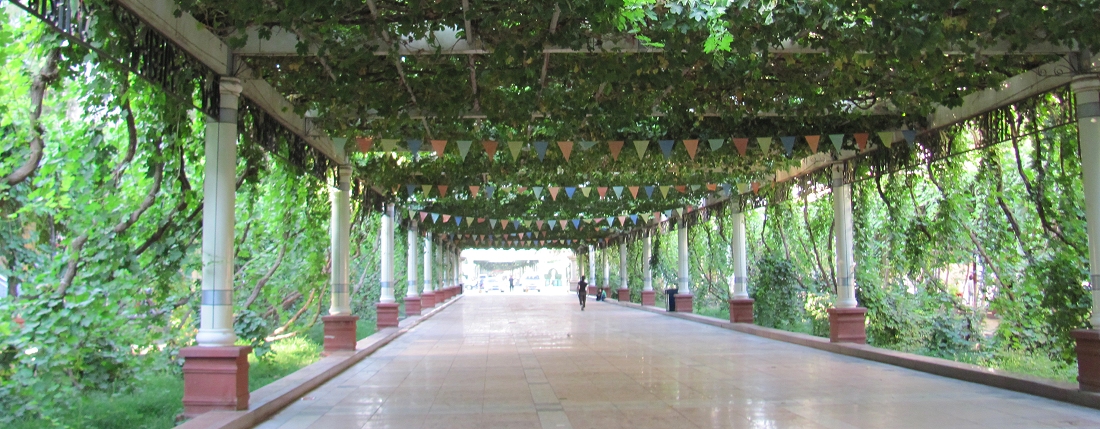
Grape arbors shade Qingnian Lu, a street in Turpan.
Day 7
Breakfast, lunch and dinner included
Overnight in Turpan
After breakfast set off to visit the Bezeklik Thousand Buddha Caves (Bózikèli Qian Fó Dong), a complex of rock-cut grottoes built by the Uighur Turks between the fifth and ninth centuries. The walls and rounded arch ceilings of the caves are covered with painted Buddhist murals. The caves are located high on the cliffs of the west Mutou Valley under the Flaming Mountains (Huoyànshan), a range of barren, deeply eroded hills in striking shades of red and ochre. In the afternoon, visit the 18th century, Afghan-style Emin Minaret (also known as Sugong Ta) built by local leaders following the conquest of the region by the Qing Dynasty. Continue to the Jiaohe ruins outside of Turpan. Jiaohe was a city established in the first century B.C. and served as an important outpost and religious center on the Silk Road until its destruction by the Mongols led by Genghis Khan in the thirteenth century. You can still see the crumbling remains of the original buildings and religious carvings. Dinner and overnight again in Turpan.
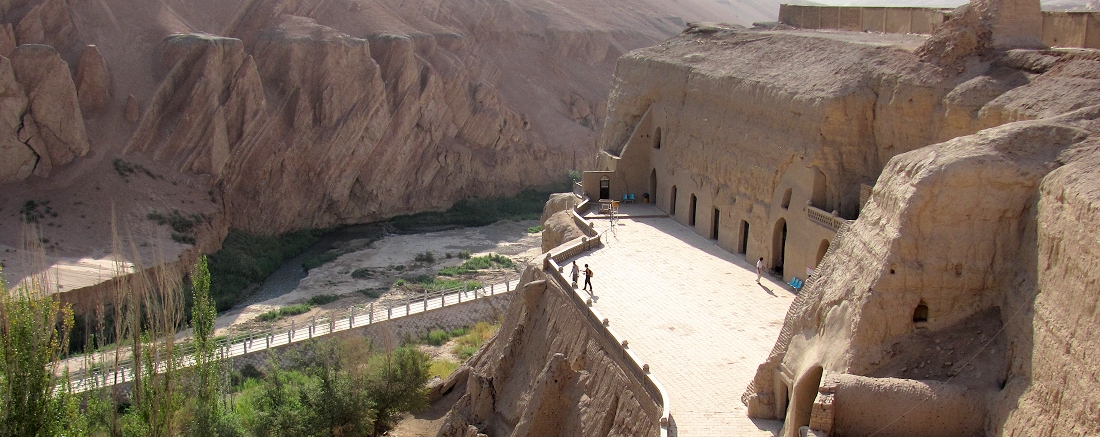
Bezeklik Caves.

Ruins of the Buddhist monastery at Jiaohe ancient city.
Day 8
Breakfast, lunch and dinner included
Overnight in Urumqi
This morning, marvel at the engineering feat of the Karez Wells, a “qanat” irrigation system composed of underground canals accessed by vertical shafts. Take a stroll along Qingnian Lu (a grape vine covered pedestrian street). Afterwards, travel by vehicle to Urumqi, capital of Xinjiang Province where you’ll visit the Xinjiang Provincial Museum known for its collection of well-preserved Tarim Basin mummies dating from the period 1800 B.C. to 200 A.D. Some of the mummies have been shown to be of west Eurasian descent. The museum also houses a rich collection of textiles and artifacts from the Silk Road. Dinner and overnight in Urumqi.
Day 9
Breakfast, lunch and dinner included
Overnight in Kashgar
Today, travel by vehicle to Tianchi (“Heaven Lake”) in the Tian Mountains (Tian Shan). This beautiful alpine lake is located high in the mountains back-dropped by snowcapped Bogda Peak. Enjoy a boat cruise on the lake and lunch in a Kazakh yurt before returning to Urumqi where you’ll board a flight to Kashgar. Overnight and dinner in Kashgar.
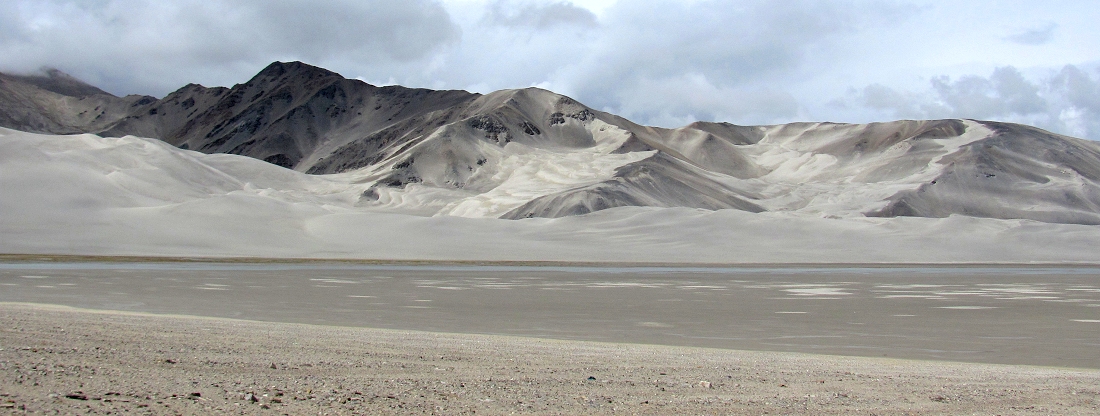
Bulong Lake and sand dunes en route to Lake Karakul.
Day 10
Breakfast, lunch and dinner included
Overnight in Kashgar
Travel to the Pamir Mountains via the spectacular Karakoram Highway and surround yourself with some of the most impressive mountain landscapes in Asia. Your destination is Lake Karakul situated at over 3,000 meters elevation (9,843 feet) and back-dropped by the imposing bulk of 24,000 foot tall Muztagh Ata (“Father of Ice Mountains”). Mount Kongur, the tallest peak in the Pamirs at over 25,000 feet, can also be seen from the highway. Enjoy lunch in a restaurant at Lake Karakul. Kyrgyz nomads live in their yurts in the pastures around the lake. Return to Kashgar for dinner and overnight.

The shores of Lake Karakul, Kunlun Mountains.
Day 11
Breakfast, lunch and dinner included
Overnight in Kashgar
Visit the Mausoleum of Abakh Khoja dating from the mid-1600s. This beautiful tiled mausoleum contains the tombs of five generations of the Afāqi family, important figures in the development of Islam in China. Also visit the fifteenth century Id Kah Mosque, the largest in China. In the afternoon, spend some time in Central Asia’s largest Sunday market where you can watch the bartering and haggling between vendors from various tribes (Uighurs, Uzbeks, Kyrgyz and Tajiks) over livestock and other goods. The nearby bazaar is a good place to buy carpets, silk scarves, pashminas, and souvenirs. Cap off your Silk Road adventure at a farewell dinner.
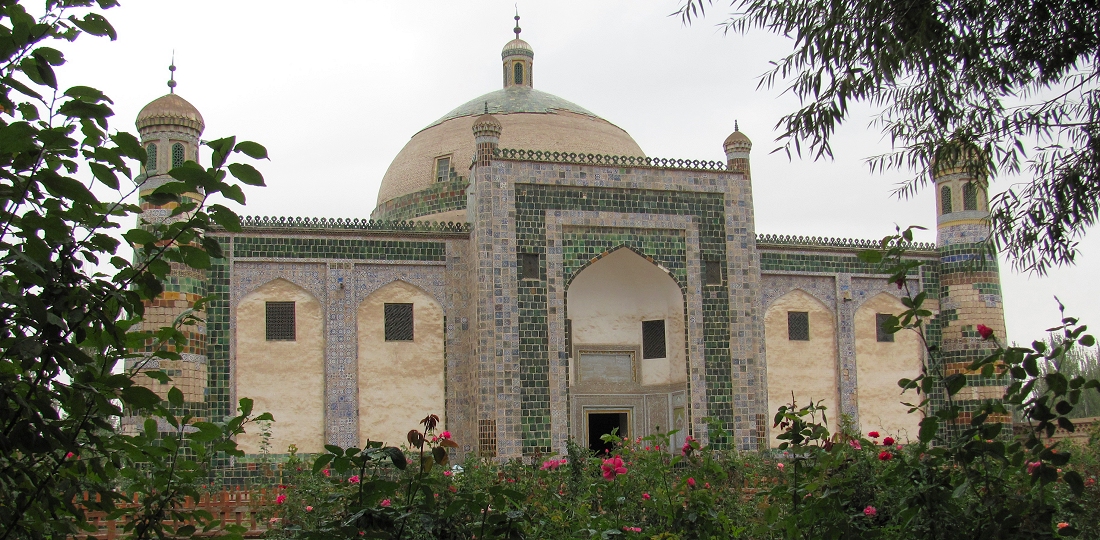
The Mausoleum of Abakh Khoja, Kashgar.
Departure Day
Breakfast included
Depart Kashgar by air to Beijing (or Shanghai) via Urumqi and your onward connections.

Khalkhas embroidery at the Xinjiang Provincial Museum in Urumqi.
We're looking forward to hearing from you! You may contact us by telephone at 503-788-9017, by e-mail (info@arttoursbyamy.com) or by completing and submitting the form below. Please enter any questions or comments in the "Message" box. PLEASE BE SURE TO MENTION THE TRIP IN WHICH YOU'RE INTERESTED. You must enter a valid email address in order to submit this form successfully. When you're finished entering information, enter the CAPTCHA code where indicated and click the "Submit" button at the bottom of this page. Art Tours by Amy does not release any of the information you provide us to any third party without your express permission.
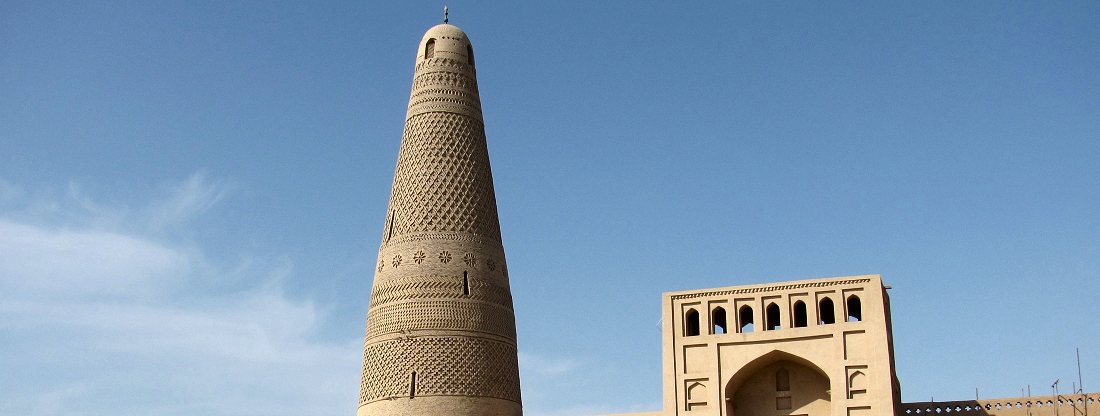
The Afghan-style Emin Minaret (Sugong Ta) in Turpan.



Recent Comments